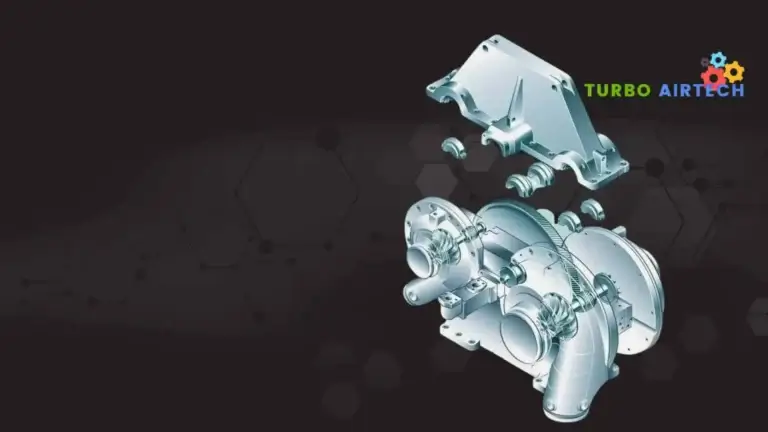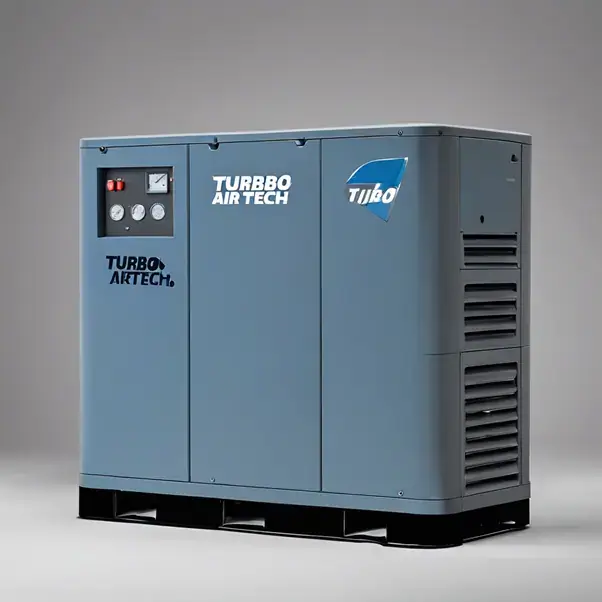
What is a centrifugal compressor?
A centrifugal compressor can be described as a dynamic machine or a dynamic air compressor. The impellers increase kinetic energy to generate pressure. The kinetic energy is converted into an increase in pressure by slowing fluid flow through a diffuser.
Centrifugal Compressor Schematic Diagram
What does a centrifugal compressor do?
A driver is attached to the centrifugal compressor rotation rotor, e.g., electric motor, steam turbine. The driver rotates the rotor of the centrifugal compressor. The impeller also rotates at high speed. The impeller's design and high rotation speed enable it to forcefully displace air from its center to its outer edges, generating a void at its core, commonly referred to as the "impeller's eye.
Through the inlet nozzle, this vacuum draws air from the outside. The impeller spins to increase the gas pressure. The high-velocity air is then directed from the impeller’s outer edge into a diffuser. Diffuser’s shape changes continuously, decreasing the velocity of the air and eventually increasing pressure rise in the diffuser. The pressure rise in the impeller is nearly equal to that in the diffuser.
Applications of centrifugal compressor
There are two types of misalignment — angular misalignment and offset misalignment or parallel misalignment, and they may occur in horizontal plane (axial) and vertical (Radial) planes. The centrifugal compressor (Integrally geared centrifugal compressor) is a type of dynamic compressor that uses a centrifugal force to increase the pressure of a fluid.
The fluid is usually composed of air or gas. The compressor consists of a rotating impeller that draws in the fluid and spins it at high speed. This increases the fluid’s kinetic energy, which is converted into potential energy by the impeller’s blades. The increased pressure of the fluid is then discharged through an outlet. Centrifugal compressors are used in a variety of applications, including air conditioning, refrigeration, chemicals, textiles, air separation, metal, and turbochargers.
They are also used in gas turbines, aircraft engines, and jet engines (turbocharger, centrifugal compressor), where they are known as turbo compressors. Centrifugal compressors are often used in applications which require an exceedingly high volume of air.Below is a YouTube video that explains the basics of a centrifugal air compressor working, components of centrifugal compressor, Main parts of centrifugal compressor with the help of centrifugal compressor working video.
Advantage of centrifugal compressor
A centrifugal compressor is a type of dynamic compressor that uses a rotating impeller to increase the pressure of a fluid. The advantage of this type of compressor is that it can achieve extremely high pressures with a small amount of power.
Centrifugal Compressor Parts
Below is a brief description of all components.
Centrifugal compressor parts
Centrifugal Compressor Casing
The outermost pressure-containing part of the compressor is the casing. The maximum discharge pressure for the compressor must be measured at the casing, compressor inlet, and outlet flanges. The casing can be either vertically or horizontally split. Horizontal split casings are bolted at the centerline at the top and bottom. The top half can be removed to maintain the internal parts. Most of the piping connections can be found at the bottom of the casing. This allows for maintenance to be performed without the need to remove any piping. The primary process connections can be found in the top or bottom halves.
Centrifugal Compressor Casing
Vertical split casings, also known as barrel type, have a cylindrical outer casing. You can insert internal parts such as the rotor assembly by rolling it inside, and then bolt the cylinder to both ends.
For low pressure applications up to 40 bar (600 PSI) discharge pressure, horizontally split casings can be used. Vertical split casings (Barrel type) can be used up to 800 bar (12,000 psi). Multistage compressor casings can be made from high/low carbon steel or carbon-alloy steel. They can be cast, forged, or plate, or any combination thereof.
Centrifugal Compressor Rotor
Rotor is the assembly of shaft, impellers, and balancing drums. It also includes thrust bearing collar, coupling hub, sleeves, and spacer rings.
Centrifugal Compressor Shaft
The shaft is typically constructed using 40NiCrMo7 material. It is machined, and impellers and spacers mounted on the middle portion. Bearings and seals are mounted at both ends.
Centrifugal Compressor Impellers
The main rotating element in a compressor is the impeller. It accelerates the gases' velocity. The compressor’s head and flow characteristics are affected by the impeller’s size and shape. There are three types of impellers:
(a) Open impellers: They have no covers on either the front or back. These impellers can be used to produce large flows on a single-stage compressor. They are rarely used for the process industry, except for air compression. However, they may be used as the first stage in a multistage compressor.
(b) Semi-enclosed impeller: This has one side enclosed and one free. Mechanical strength is increased by the shroud (enclosing plates). These impellers have higher efficiency than open impellers. They are used in multistage compressors as well as single-stage compressors for high flow rates.
(c) Enclosed impeller – Here, the vanes are placed between the two discs. These vanes are used primarily in multistage compressors. This impeller is most popular and has the widest flow range.
Impellers can be further divided based on how they take the gas in.
(a) Single suction impellers. It only takes the gas in an axial direction.
(b) Double suction impellers. It moves the gas in an axial direction at both ends of the impeller. These impellers are equivalent to two single-inlet impellers positioned back-to-back. They can manage twice as much flow at the same head as a single impeller.
Types of Centrifugal Compressor Impellers
Diaphragm
The stationary element within the casing is called the diaphragm. It contains the diffuser that allows the gas to exit the impeller, and a channel that redirects the gas through the return passageway into the next impeller. It can be fabricated or cast. They are cut in half for easy installation of the rotor.
The diaphragm halves of a vertical split-barrel compressor are held together by tie rods, creating two separate bundles. They are bolted together after installing the rotor. The assembled assembly is then placed in the casing axially. Each diaphragm is installed in its own half in horizontal split casing. Each diaphragm’s outer surface has a groove that can be combined with the casing relief. After fitting the rotor and other components into the lower half, bolt the upper half together with the casing and diaphragm.
Centrifugal Compressor Bearings
The compressor’s rotor is fixed axially by a thrust bearer and rotates on two journal bearings. The journal bearings are located at each end of the rotor. The thrust bearing is mounted on the opposite side of the coupling. Below is a brief description of both bearings.
Thrust Bearing
Thrust bearings can be used to limit axial motion. The thrust collar is hydraulically fitted to the rotor and rotates with it. Thrust bearings are equipped with a stationary thrust surface, thrust plates and a thrust collar that revolves with the shaft. Normal conditions have a thin oil layer between the thrust collar and the thrust shoe. The thrust shoes prevent any axial motion.
Tapered and flat land bearings are both used but less often. Most commonly, tilting pad thrust bearings will be used.
The tilting pad thrust bearing consists of a career ring which holds the thrust shoe. Thrust shoes prevent any axial movement of the shaft collar in either direction. The thrust collar will only allow certain thrust pads to receive axial movement loads from the thrust collar.
This load is then passed on to the equalizing levers. The equalizing levers adjust the load so that all pads are equal. Bearing housing contains the inlet and outlet for oil. The oil keeps the thrust collar and thrust shoes from touching in normal conditions. It helps prevent wear and tear and helps to remove excess heat.
How a tilting pad thrust bearing works
Journal bearing (Radial Bearing)
Journal bearings use pressurized oil fluid film to support the rotating shaft. The journal is the portion of the shaft that is supported by the bearing.Straight sleeve bearings can be used for units that have a short bearing span and low speeds.
A pressure-dam sleeve bearing is another type, but Tilting pad bearings are the most common. They are resistant to the unbalancing action from the oil firm.Tilting pad radial bearings consist of 4 to 5 pads, which are located circumferentially as well as radially by stop pins and axially with end plates. Stop pins can also be used as oil supply nozzles.
Standard pads can be used in either direction of rotation because they are center pivoted.The bearing housing will contain the shaft. There will be a slight clearance between the shaft and the bearing pads.
The bearing is supplied with a pressurized oil to fill this space. The oil pressure will prevent the shaft from rotating and make it less contactable for both the pad and the shaft. This will allow the shaft to float between, achieving contactless bearings with less wear.
Centrifugal Compressor Seals
Shaft seal.
Two shaft ends seals are used, where the shaft emerges from the casing.(a) Reduce leakage of process gases (which are being compressed), from the inside to the outside of the compressor.(b) Prevent oil vapor or outside air from entering compressor, and to mix with process gases.
Dry gas seals
Because of their reliability, utility, and environmental benefits, dry gas seals are now the standard for centrifugal compressors. Two mating rings make up dry gas seals. One is stationary, the other is rotating. They are kept in close contact by the spring when the compressor is off.
The compressor spinning at high speeds will produce hydrodynamic forces that will push the stationary ring against its spring. This will cause a gap between the rings of approximately 2 to 5 um. The sealing system is supplied with an external sealing gas that has slightly higher pressure than the compressor’s gas.
This gas will pressurize the area between the rotating rings and the first labyrinth (adjacent to the process gas side).It will pass through the compressor’s interior, but because of the labyrinth restriction, the process of escaping the compressor will take place very slowly. There will always be positive pressure within the seal system.
The remaining sealing gas will pass through the work gap and function as a fluid.The working gap is extremely thin so the amount of sealing gas that escapes through it will be much lower. Any sealing gas that escapes through this will be sent to the vent system.
Because the rings do not touch one another, this arrangement does not require any lubrication. By using o rings, the stationary ring can be sealed in a sealing case. Combining two or more dry seal arrangements in series is known as “tandem dry seal.”
Tandem Dry gas seals are in operation.
Tandem gas seal is a combination of two dry seal systems in one cartridge. The primary gas seal is the 1st. Any leakage is sent to a vent system. Secondary seals are the two, which function as backups in case of primary seal failure. An inner labyrinth sealing device is located inboard the dry gas seal. This seal separates the process and gas.
As mentioned, external primary gas is supplied into the primary seal. Most of these will pass into compressors. Little will pass between stationary and rotating faces. Then it will be vented to the primary vent. Secondary seal is supplied with secondary gas. Some of the secondary gas will pass through intermediate labyrinths and be vented through primary ventilation. This will also prevent primary seal gas from entering secondary vent through intermediate labyrinth.
The secondary seal gas may also pass through the gap between stationary and rotating face elements within the secondary seal. This secondary vent will eventually allow the secondary gas to escape. Bearing housing is located adjacent to the seal cartridge on the compressor shaft.
The separation/barrier gas is used to prevent the lubricating oils from entering the sealing system and mixing with the process gases. Oil will not be allowed to pass through the bearing housing through the labyrinth. However, some oil will flow through the inner labyrinth to exit through the secondary vent.
Labyrinth seals
The outer diameter of the rotating shaft or the inner diameter of shaft seals are both marked with sharp edges on labyrinth seals. Labyrinth seals can be either stationary or rotating. As a small amount of gas leaks, the pressure drops across each ridge to seal it. The flow resistance is reduced gradually over the labyrinth teeth to seal.
Labyrinth seals for air compressors
Balance drum
A centrifugal compressor will have a net axial force or thrust acting towards the suction side because the pressure on its discharge side is. Greater than that at its suction side. This net axial force is called discharge pressure Pd- (minus) suction pressure Ps.
Ps suction pressure acts upon the impeller, and it is increased to P1 at its tip. P1 will play on the suction and discharge sides of the 1st and 2nd impellers, respectively. It will become P2 at the tip of the 2nd impeller and continue the cycle until the discharge impeller.To counter this, a balance drum on the discharge side is installed. Through an external pipe spool, the discharge side of the balance drum is connected to its suction side.
This will ensure that the pressure on the discharge side equals the suction Ps. The discharge pressure Pd will also be applied to the balance drum.This arrangement will give rise to a second net axial force, Pd-Ps. This net force will act in the opposite direction to discharge and cancel out any previously calculated Pd-Ps that was acting towards suction. The thrust bearing can take care of any remaining forces that may have been generated by other factors.
Coupling
The coupling transfers power from the driver to the compressor. You can either use a speed increasing gear or direct coupling. Toothed couplings can be used with filling or force-feed lubrication. Force-feed lubrication couplings are for high rotation speeds and are only used in compressors. A second type of coupling is sealed. These couplings require lubricating grease to fill every now and again. They are only used on slow speed shafts.
Frequently asked questions
What is a centrifugal compressor?
A centrifugal compressor can be described as a dynamic machine or a dynamic air compressor. The impellers add kinetic energy to create pressure. The kinetic energy is converted into an increase in pressure by slowing fluid flow through a diffuser.
How does a centrifugal compressor work?
A centrifugal compressor is a type of dynamic compressor that uses a rotating impeller to increase the pressure of a fluid. The fluid is typically air, but can also be other gases or liquids. The impeller rotates at a high speed, and the fluid is forced outwards from the center of the impeller to the periphery. This increases the fluid’s pressure and temperature from the kinetic energy of the gas.
What are the advantages of using centrifugal compressors?
Centrifugal compressors are widely used in industry because they are simple and efficient. The main advantages of using centrifugal compressors are: -They can manage large volumes of air or gas-They can operate at high pressures-They are quiet-They require less maintenance than other types of compressors
Axial vs Radial Centrifugal Compressors: Key Differences
The main difference between an axial centrifugal air compressor and a radial centrifugal compressor (two types of centrifugal compressor) is the direction of airflow. In an axial flow compressor, air flows parallel to the axis of rotation, while in a radial compressor, air flows perpendicular to the axis of rotation. This means that an axial compressor is more efficient at compressing air than a radial compressor.


